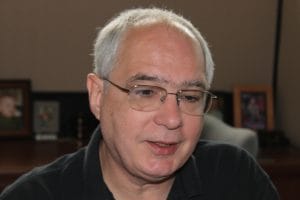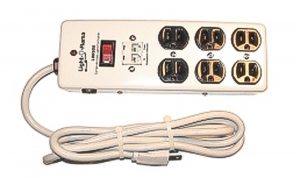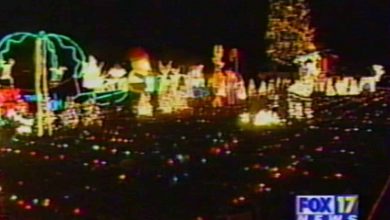Light-O-Rama
Tried, true and dependable

In 1975 Dan Baldwin was a newly minted computer science wizard and had just married his longtime sweetheart, Mary. That first Christmas together they bought a three foot tree upon Mary’s insistence and a family tradition was born. For the next 20 years that little tree, plus some accessories, was just about all the decorating the couple did for the holiday season.
Something changed in 1995 when Mary took it upon herself to go outside and string a few lights along the top of the fence. Dan looked at her work and said “we need more lights!” Soon there were lights in the bushes, a new nativity scene in the yard as well as the obligatory Santa and four tiny reindeer. The decorating bug had bitten

the Baldwin family.
In the beginning the light animation consisted of X-10 modules. Dan was so proud that with the press of one button the entire display could be turned on or off. Soon he started playing with other light switching ideas as he merged his technical talents with the fun of decorating for the holiday season.
Over the years Dan and Mary’s home display grew at an astonishing rate. To handle the power load they had to increase their service from the local utility. They installed 36 dedicated 120 volt 20 amp circuits for the regular lights and two 240 volt 60 amp circuits for the megatrees. The Baldwin extended family of some 20 members would spend the long Thanksgiving weekend putting up the grand display.
Mary admitted she thought it was “a little insane” but the project had become a family tradition everyone enjoyed.

By 2002 Dan was using a computer stuffed with DIO (direct input/output) boards controlling over 1100 electrical circuits. 25 conductor control cables were snaked from the nerve center in the basement all over the yard to what the family called R2D2’s that handled the power switching and distribution to the lights. Music was MIDI (musical instrument digital interface) based and Dan used a bit of MIDI magic to flash the lights to music so no programming was required.
The biggest challenge wasn’t the technology but nature. Squirrels loved eating the wires and soon became especially fond of megatrees. The Baldwin’s lost 5000 lights in just one day but had some very happy critters running through the yard.
During all this time Dan did work inside the famous AT&T Bell Labs and become a vice president of software development for a company in New Jersey close to New York City. Life was good.
In 2002 Dan stepped back and admitted his Christmas display was getting too complicated. Everything was home-brew/DIY (do it yourself) when he suddenly had one of those ‘aha’ moments. He realized others wanted to get into creating great displays, didn’t have the technical talent and had no idea where to start. They needed the computer magic and he knew how to do it. A potential new company had just been conceived.
Dan always had a fascination with company names from the 1950’s and thought Light-O-Matic would be perfect for his new venture. Someone already had snagged the Internet name and on April 24, 2002 Light-O-Rama was born at www.LightORama.com.
Dan looked hard at what was currently available for the DIY community and knew the keys to success would be a reliability, versatility and ease of use. The first products for the company had to include some sort of gizmo to switch electrical circuits on/off with computer commands along with a program to create the light patterns and keep everything synchronized to music. Dan also decided his switching product had to be able to dim/brighten the circuits since no one else was doing it. He had too much to do with so little time and he was working a full-time job to support the family.
The Internet bubble had burst so the developers under his command at the software company had a little extra time on their hands. To keep everyone busy he challenged them to create some sort of tool to blink lights in patterns to music. They soon came up with their version of what we now call grid sequencing. Each cell of the grid represents a particular electrical circuit and a point in time. As you scanned the grid from left to right, repeatable light patterns could be created and kept in sequence with the music being played. Programming was easy. Click a cell in the grid and it would toggle on or off. Drag the cursor across multiple grid cells and the electrical circuit would fade up or down.

While the software developers did real work with a touch of Light-O-Rama on the side, Dan was working in his garage and basement designing the hardware and firmware to do the circuit switching magic. The prototype was what can only be called a smart six outlet power strip. It was an off-the-shelf product that had been totally re-engineered on the inside so the switching triacs and control electronics would fit. The software could individually switch any outlet on the power strip. It didn’t prove too practical so he soon designed just a printed circuit board that could handle eight electrical channels. The CTB08 Modular Controller was born. What did the CTB mean? Computer Triac Board. It went on sale for $79.95 fully assembled and was later followed by kit versions for those willing to do their own soldering.
Now that Light-O-Rama had designed and built the initial product suite of hardware and software controllers Dan assumed people would beat a path to his door ready to buy. The problem was no one knew Light-O-Rama existed, at least until later that year when he stumbled upon an odd little website called www.PlanetChristmas.com with its very active user forums. Dan had found where all the over-the-top decorators hung out.
Light-O-Rama sales were non-existent for the longest time. Dan made the decision to make a formal introduction to the decorating community by being a vendor at PLUS2003 (now called Christmas Expo.) From that show came the first order for $446 from David Horting. The rest, as they say, is history.

The company was being run out of the Baldwin house with the final product assembly done in his garage. Dan ran out of space and luckily his mom had a huge garage but she lived in upstate New York. They rebuilt her garage to make it more work friendly and added HVAC. By now more members of the family were getting involved assembling the products and his mother loved it because she could see everyone more often. At times Dan’s mother would help assemble the controllers and late at night his sister would pack up the car, drive to the state line (which was half way), meet Dan and transfer the new inventory so it could be shipped the next day from Dan’s house in New Jersey.
Light-O-Rama needed more of Dan’s time as he was plowing all of the family savings into the company. In 2005 he thought the time was right, quit his real-paying job and moved to Hudson Falls. It just happened to be where he grew up and close to his mother’s garage. The not-so-good news was he had to leave Mary in New Jersey until things settle down. Dan says it was a difficult time. Mary caught up with him a year later.
About the same time Dan had left the security of the software company so he could focus on Light-O-Rama, John Potochnak retired from the same company and was looking forward to a life of leisure. It lasted seven months before he was bored and started looking for something to do. John called Dan and soon became part of Light-O-Rama. John saw it as a good investment and brought financial stability to the new company as well his impressive design engineering experience. The best kept secret is John’s behind the introduction of Light-O-Rama’s Cosmic Color Ribbon.

By early 2006 mom’s garage was packed and out of expansion room. Dan found the perfect production space in South Glens Falls that allowed for significant growth in the future. Light-O-Rama is still there today but has outgrown the original space and expanded into more. The company still uses his mother’s garage for staging Light-O-Rama kits.
What happened to Dan’s wife, Mary? In 2001 their son Alex joined the family so she suspended her job as a nurse to become a full-time mother. That job soon evolved into helping Dan at Light-O-Rama when needed. Now Mary spends all her time in a fancy new office at Light-O-Rama. She’s a vital part of the growing company and in charge of order fulfillment. If you’ve ever called, you might have even talked to her.
Is it easy in small business? Nope. Just ask Dan.
Dan will quickly tell you it’s a lot of very hard work running a company. When he’s not in the office, he’s at home logged into the office. The first six months of the year are devoted to recovering from the last year and creating products for this year. The last six months are dedicated to just making it through the rest of the year. The phone begins ringing steadily in July as the world starts to think about Christmas. By September there are no more free weekends for the family. In November the company is handling 200-500 calls a day plus another 500 emails and trouble tickets from the helpdesk. Dan also gets to hear the UPS drivers constantly complain about having too much stuff to put in their trucks. Even when Dan and Mary go home for dinner, they’re responding to emails while eating. Dan calls the last quarter of any year a blur. Mary just calls it exhausting.
I got Dan to start reflecting on the history of Light-O-Rama and asked if there was anything he would do differently today. He opened up and said he had made plenty of mistakes over the last ten years. The first major lesson learned the hard way came with the release of the second generation sequencing software called S2. He thought it was almost ready to go and told the world, only to find the software had issues and it wasn’t ready for prime time until 18 months later. You’ll never hear the company talk about a product until it’s all-but-ready to ship.
Then Dan started talking about the product shortages of 2011. The company had redesigned the controller boards to what they now call G3 (Generation 3) and was confident of a smooth manufacturing transition. Light-O-Rama underestimated the product demand, but they were too far down the G3 path to backup and restart the old production lines because of component lead times. Then they were blind sided by extra production time needed by all three of their board manufacturers as they shifted to the new design. Each company had a different excuse why product couldn’t be delivered on time, yet no one had timely solutions. Both Dan and John made some tough decisions and product finally started flowing, though many weeks late and after paying substantial financial incentives to the board production companies. Neither Dan nor John want to re-live 2011.
Light-O-Rama products are manufactured in Asia and the USA. Products for this Christmas season are already arriving at the Light-O-Rama warehouse. John took an extra precaution and ordered Asia to send product to the USA on different ships. If one shipment has a delivery issue Light-O-Rama will still have product heading to the warehouse via a different route. Sounds like the company has learned its lesson well from 2011 and there will be plenty of product available when needed this year.
What’s new for 2012? Keep in mind Dan doesn’t like to talk about new products before they’re all-but-ready to ship. PlanetChristmas did a little digging and caught a glimpse of what’s heading our way. This is double-top-secret information and subject to change so don’t share it with anyone.
Cosmic Color Pixels, Bulbs and Floods are being rolled out to compliment the RGB based Cosmic Color Ribbon.
There’s a new ShowTime MP3 Director with a much more powerful internal processor that can drive two data networks.
ShowTime Central will be introduced and packages a mini-Director and FM transmitter in the same enclosure. It’s one more step toward simple plug and play solutions.
The S3 software SuperStar add-on is getting new capabilities added to the existing Instant Sequence feature. It’s a great solution for when you need something sequenced in a hurry (think weddings, birthdays and parties.)
The off-the-shelf sequence selections are being expanded and are all designed for 48 channel displays. Initially there will be a separate on-line storefront dedicated to these sequences
The Light-O-Rama website is being totally reworked to make it easier to find information.
The Light-O-Rama forums will be migrated to a new host to add more social networking features. A new emphasis will be put on treating everyone with dignity and respect. Bullying of any sort will not be tolerated. Both John and Dan are quite committed to this.
Is there more? Yep, but apparently it’s super-double-top-secret and the information can’t be shared outside the walls of Light-O-Rama.
Wrapping up the inter
view with Dan and Mary Baldwin, I asked if there were any high points during their ten year ride. Mary was quick to say she really enjoyed working closely with her husband but the family missed being able to have a Christmas display since they spent all their time working at the company.
Dan paused for the longest time and finally said he was amazed at what people were doing with Light-O-Rama products. The enthusiasm shared by so many and the special bonds that had been formed within families as they decorated meant the world to him. I saw a tear running down his cheek. Enough said. The interview was over.
This article was included in the July 2012 issue of PlanetChristmas Magazine.
By Robin Williams




